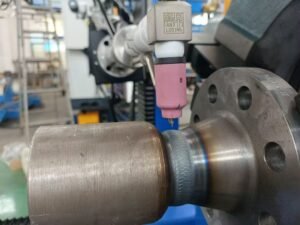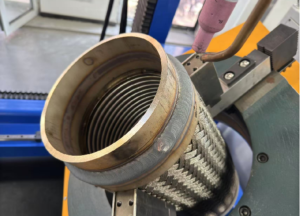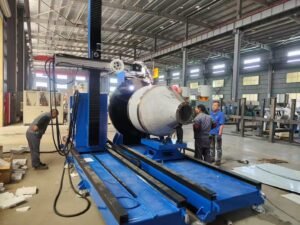Weld strength is a critical factor in ensuring the safety and reliability of welded structures. As welding remains a fundamental process for joining metals, the strength of the weld directly determines how well a structure can withstand various loads, such as tension, compression, bending, and shear. If a weld lacks sufficient strength, the structure may fail due to fractures or excessive deformation, which can lead to severe consequences.
In this blog, we explore the key factors influencing weld strength, testing methods to evaluate it, and practical strategies to improve it.
Key Factors Affecting Weld Strength
1. Welding Method
Different welding methods—such as manual arc welding, gas-shielded welding (e.g., MIG/MAG and TIG), and submerged arc welding—impact weld strength based on their heat input and weld formation characteristics. For instance:
TIG welding offers superior weld quality due to its shielding gas protection, making it ideal for applications demanding high weld strength and precision.
Manual arc welding provides flexibility but requires careful control of heat input. Excessive heat can cause coarse weld microstructures, reducing strength.
Welding parameters, including current, voltage, and speed, also play a critical role. High welding currents can cause overheating, leading to defects like porosity or slag inclusions, while excessively high speeds may result in poor fusion.
2. Welding Materials
The choice of welding consumables (e.g., electrodes, filler wires, flux) directly affects weld performance. Selecting materials that match the base metal’s strength and chemical composition is crucial:
If the filler material has lower strength than the base metal, the weld will become the weak point of the structure.
Conversely, overmatching filler materials can introduce issues like cracking due to excessive hardness.
Proper flux selection is also essential as it protects the molten pool and improves weld metal properties.
3. Base Metal Properties
The chemical composition and mechanical properties of the base metal fundamentally influence weld strength. For instance:
High carbon content can lead to hardened zones and increase susceptibility to cracking during welding.
Different metals, such as carbon steel, stainless steel, and alloys, require specific welding methods and consumables to achieve optimal results.
4. Weld Joint Design
The type of weld joint significantly impacts how forces are distributed across the weld. Common joint types include butt joints, lap joints, and fillet joints:
Butt joints primarily handle tensile or compressive loads and require uniform fusion for strength.
Lap joints face shear forces, requiring careful consideration of both shear and tensile strength to prevent failure.
5. Welding Defects
Defects such as porosity, slag inclusion, cracks, incomplete fusion, and lack of penetration are detrimental to weld strength. For example:
Porosity reduces the effective load-bearing area of the weld.
Cracks act as stress concentrators and can lead to sudden failure under load.
Careful quality control is necessary to detect and mitigate these defects.
Pipeline Circumferential Automatic Welding
Weld Strength Testing Methods
1. Tensile Test
The tensile test is a standard method for evaluating weld strength. Welded specimens are subjected to tensile forces until failure. The tensile strength is calculated as:
Tensile Strength = Maximum Load / Weld Cross-Sectional Area
This method directly measures the weld’s ability to resist tensile forces, providing valuable insights into its performance under tension.
2. Bend Test
The bend test evaluates weld ductility and strength under bending loads. During the test, a welded sample is bent to a specified angle while observing for defects like cracks or fractures. This test is particularly useful for assessing the weld’s flexibility and overall quality.
3. Shear Test
Shear tests measure the weld’s resistance to shear forces, which is especially relevant for lap joints. In this test, shear forces are applied until failure, and the shear strength is calculated as:
Shear Strength = Maximum Shear Load / Effective Weld Area
This method helps determine the weld’s ability to handle shear-dominated applications.

Our Automatic Welding Machine
Strategies to Improve Weld Strength
1. Optimize the Welding Process
Choosing the right welding method and carefully controlling parameters like current, voltage, and speed is essential. For instance:
Use gas-shielded welding for thin materials to achieve precise, high-quality welds.
For thick materials, employ multi-pass welding to ensure even heat distribution and fine weld microstructures.
2. Select Appropriate Welding Materials
Match the filler material’s strength and composition to the base metal. For stainless steel, specialized stainless-steel electrodes or wires must be used to maintain strength and corrosion resistance.
3. Thorough Preparation of Base Metal
Proper surface preparation is critical to avoid weld defects:
Clean the base metal to remove contaminants like oil, rust, and oxide layers.
Ensure proper joint preparation, such as accurate beveling for butt joints, to improve weld fusion.
4. Quality Control During Welding
Implement real-time monitoring of welding parameters to maintain consistent quality. Use non-destructive testing (NDT) techniques, such as ultrasonic testing or radiographic inspection, to identify and repair defects before they compromise weld strength.
Conclusion
Weld strength is a cornerstone of structural integrity in welded components. By understanding the factors that influence weld strength, applying rigorous testing methods, and adopting effective improvement strategies, weld reliability can be significantly enhanced. Whether you’re working with simple joints or complex structures, ensuring strong and defect-free welds is essential for safety and performance.




1 comment on “Understanding Weld Strength: Factors, Testing Methods, and Improvement Strategies”
The text has a meditative energy. It unfolds thoughtfully, allowing insight and emotion to surface organically rather than demanding attention.